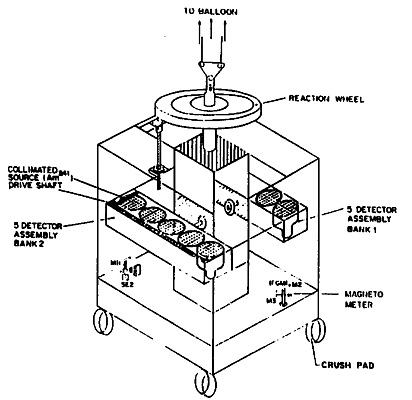Purpose of the flight and payload description
The TICAL MARK II X-Ray telescope was the second generation of a high sensitivity Nal/Csl phoswich X-ray telescope (area 1000 cm2) composed by two banks of five detectors each, collimated to a field of view of 5° x 5° FWHM. The telescope was built under a cooperation program between the Tata Institute of Fundamental research from India and the University of Calgary from Canada.
In the image at left we can see an scheme of the telescope (click to enlarge). Each detector consisted of a Nal(TI) scintillator (5mm) and a Csl (Na) scintillator (50 mm) of area 100 cm2 viewed by a single 127 mm diameter photomultiplier and equipped with a graded shield collimator.
Non-X-ray background photons were rejected by requiring that only signals characteristic of Nal (and not Csl) -as revealed by the pulse shape- were accepted. This "phoswich" technique reduced the background at ceiling altitude by a factor 10 to 20. The detectors have good efficiency in 20-150 keV range. The two banks of detectors were mounted, one on each side of central column, on a platform steerable in both the azimuth and the zenith to track the X-ray sources as they moved on the sky. An Am-241 radio-active source was used to periodically calibrate each detector. Signals from each detector, the telescope aspect and the house-keeping information were telemetered to ground. The arrival time of an X-ray photon were determined with great accuracy. This high time resolution was especially valuable in search for short (millisecond) periodicities in the X-ray sources.
Details of the balloon flight
Balloon launched on: 3/24/1990 at N
Launch site: TIFR National Balloon Facility, Hyderabad, India
Balloon launched by: National Balloon Facility, Tata Institute of Fundamental Research
Balloon manufacturer/size/composition: Zero Pressure Balloon Winzen Stratofilm (tow+main) 242.900 m3
Flight identification number: 406
End of flight (L for landing time, W for last contact, otherwise termination time): 3/24/1990
Landing site: Control instrumentation failure. Payload lost
Payload weight: 719 kgs
Overall weight: 1.205 kgs
Control instrumentation failure.
External references
- Balloon Flight Report 1969 -2003 TIFR website (via Archive.Org)
- New balloon-borne telescope system TICAL-Mark II for hard X-ray astronomy Advances in Space Research, vol. 14, no. 2, p. (2)101
1050If you consider this website interesting or useful, you can help me to keep it up and running with a small donation to cover the operational costs. Just the equivalent of the price of a cup of coffee helps a lot.


